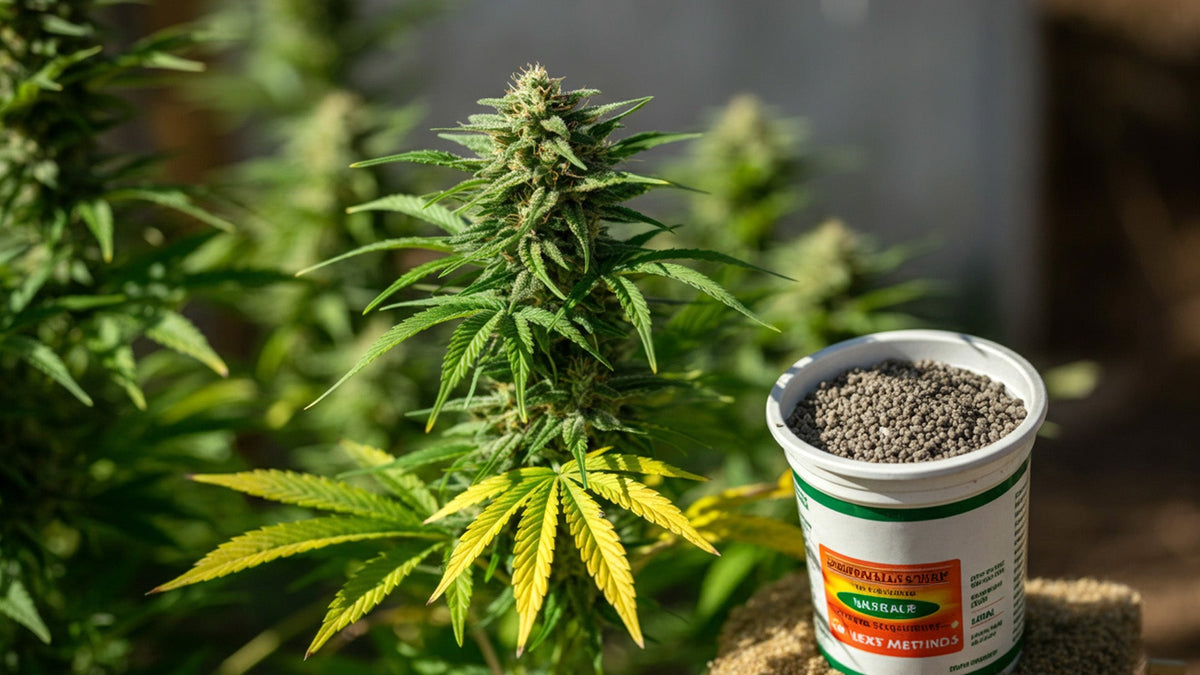
How to Avoid Cannabis Over-Fertilization: Guide
|
|
Time: 6 min
Are you 18 years old or older?
I hereby declare that I am over 18 years of age and I also declare that I am aware that the following pages contain information about cannabinoid products.
Sorry, the content of this store can't be seen by a younger audience. Come back when you're older.
|
|
Time: 6 min
Do you know the dangers of cannabis over-fertilization and how it affects your plants? It happens when plants get too many nutrients. This causes salt buildup, damages roots, and slows down growth.
It's key to know why and how to spot over-fertilization. By noticing the signs of nutrient burn early, you can fix it. This blog will help you avoid long-term harm and ensures a good harvest.
Table of Content
Key Takeaways
It's important for cannabis flower growers to know why over-fertilization happens. This issue occurs when plants get too many nutrients. It can really harm them.
Using too much fertilizer is a big problem. Strong fertilizers can block plants from getting the nutrients they need. This can make leaves turn yellow and get burnt.
Using the wrong fertilizer at the wrong time is another issue. Plants need different nutrients at different stages. For example, they need more nitrogen when they're growing and more phosphorus and potassium when they're flowering.
To keep plants healthy, growers need to manage fertilizer carefully. They should watch how plants react to fertilizers and adjust as needed. This helps avoid giving too much fertilizer.
It's important for cannabis growers to know the signs of over-fertilization. This can harm plants in many ways, from cosmetic damage to serious health problems.
Yellow leaves are a common sign of over-fertilization. This happens when plants get too many nutrients. It leads to an imbalance that can turn leaves yellow or discolored.
Burnt leaf tips are another sign of too much fertilizer. Too many salts in the fertilizer can burn the leaf tips. They may turn brown or yellow.
Over-fertilization can also stunt plant growth. It makes it hard for plants to absorb nutrients. This can slow down growth and reduce yields.
Symptom |
Description |
Cause |
Yellowing Leaves |
Leaves turn yellow or become discolored |
Nutrient imbalance due to excessive fertilization |
Burnt Leaf Tips |
Leaf tips become burnt or crispy |
Excessive fertilizer salts |
Growth Stunting |
Reduced growth rates and smaller yields |
Impaired nutrient absorption due to over-fertilization |
Over-fertilization can show up in many ways. It's key to spot the signs early. Cannabis plants that get too much fertilizer may look different.
One sign is curled leaves. This happens when the plant can't take in too many nutrients. Leaves might curl down, making the plant look odd.
In bad cases, too much fertilizer can hurt the roots. High nutrient levels can burn the roots. This stops the plant from getting water and nutrients. Spotting these signs early is important to fix the problem.
Check your plants often to see if they're getting too much fertilizer. Look for signs like curled leaves and salt on the soil. Knowing what over-fertilization looks like helps keep your cannabis plants healthy.
Over-fertilizing can harm cannabis plants. But, there are ways to fix and help them get better. To treat over-fertilized cannabis, you need to flush the soil and adjust the nutrients.
The first step is to flush the soil with water that's the right pH. This removes extra salts and nutrients that can hurt the roots and leaves.
After flushing, you need to change the nutrient mix to avoid over-fertilizing again. This might mean using less nutrients or a more balanced fertilizer.
By following these steps, growers can fix over-fertilized plants and help them heal. Keeping an eye on the plants and adjusting the nutrients can stop over-fertilization from happening again.
To get a big harvest of cannabis, it's important to avoid over-fertilizing. It's better to prevent it than to fix it later. This saves time, money, and stress. With a few simple steps, cannabis growers can keep their plants healthy and productive.
One key way to stop over-fertilizing is to use a good feeding schedule. Plants need different nutrients at different times. For example, seedlings need less than plants that are flowering.
It's also important to keep an eye on pH and EC levels. If pH is off, nutrients won't be available. High EC means too many nutrients in the soil. To keep these levels right:
By following these tips and knowing what your plants need, you can lower the chance of over-fertilizing. This way, you'll grow a healthier crop and get more cannabis products from your plants.
Effective cannabis cultivation needs a deep understanding of nutrient management. Knowing the causes and symptoms of over-fertilization helps growers prevent nutrient burn. This ensures healthy plant growth.
To treat over-fertilization, growers should flush the soil and adjust nutrient levels. It's important to follow proper feeding schedules and check pH and EC levels. These steps help prevent over-fertilization and improve yield and quality.
Healthy feeding practices are key to achieving the best results. By understanding how to treat over-fertilization and taking preventive steps, growers can have a successful harvest. This guide is a valuable resource for improving cannabis cultivation practices, and avoiding cannabis over-fertilization.
“Over-fertilization is the silent killer of cannabis grows.”
To avoid over-fertilization, use the right feeding schedule for each growth stage. Check pH and EC levels often. Choose high-quality fertilizers and follow the instructions.
Yes, neglecting over-fertilization can harm plants permanently. It can damage roots and stunt growth. This can lower the yield and quality of buds.
Any nutrient can cause over-fertilization if used too much. But, too much potassium is a common issue. It's key to balance nutrients according to plant needs.

